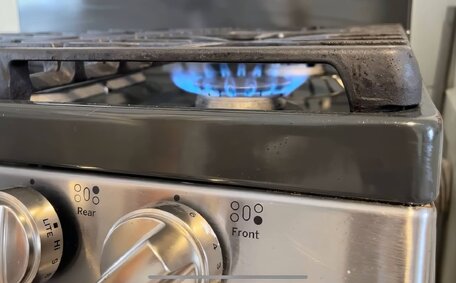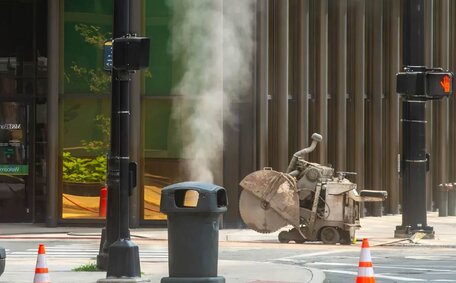Understanding Your Gas System
Your home’s gas system includes the gas meter, supply pipes, shutoff valves, and key gas appliances. The gas meter measures usage and is typically situated outside by your property line, allowing you to shut off the supply when required.
Underground gas pipes, connected to your gas meter, gas infrastructure and each appliance, deliver natural gas to your personalised space and control over the gas flow.
Your gas provider maintains the gas meter and associated underground pipelines up to the boundary of your property. As a homeowner, you’re responsible for safely disconnecting gas and shutting off the supply to your internal pipes and appliances. Knowing how to turn off your gas quickly is crucial for safety during leaks or emergencies.
Locating the Gas Meter and Shutoff Valve
To locate your gas metre and shutoff valve:
- The gas meter is usually mounted on your home’s exterior sidewall. It could be in a meter box shared with your electrical meter or in a separate gas-only box.
- Unlocking the meter box reveals the valve, typically on the main pipe entering your property. Trace the pipe to accurately locate the valve, the primary control point for your gas system.
- By rotating the knob to a perpendicular position with the pipeline, you stop the gas flow beyond this point.
- Test that it’s safe by ensuring the gas has been turned off by trying to light your gas stove or water heater pilot light. You may notice a gas smell briefly as residual off gas supply from your pipes escapes. It is paramount to ensure there’s no risk in your environment during this trial and that no appliances will accidentally ignite, ventilating the space if necessary.
Teach every household member the locations of the gas meter and shutoff valve, ensuring they can turn them off quickly and safely in an emergency. Rather than attempting DIY repairs on your gas installations, seek the expertise of professional gas fitters.
Identifying Different Types of Gas Meters
Houses in Rockdale mainly have two types of gas meters:
Dial Metres
Dial meters, with clock-like dials, register your gas usage and prevent unintentional supply. These meters display natural gas usage in cubic feet or cubic metres for LPG, which can be converted to cost estimates. Read from left to right to determine gas consumption.
Digital or Smart Metres
Digital meters, with their electronic displays, provide instant gas usage data, surpassing traditional dials in detail. They display real-time usage of natural gas or LPG in cubic units. Smart gas meters transmit usage readings to gas providers wirelessly.
When communicating with gas technicians, knowing your metre type and reading it correctly can help identify leaks or issues. Familiarize yourself with reading your meter type by inspecting it regularly, located outside near the gas supply valve. Reach out to a licensed expert should you encounter difficulties ascertaining the metre style or interpreting it at the main shutoff valve.
Accessing and Operating the Gas Shutoff Valve
Adhere to the following steps for a safe turn of your gas shutoff valve:
- Locate the meter box, often found on the external wall of your residence or near the property boundary, to learn how to shut off your gas.
- Unlock the gas meter box using the key from your gas company. Use tools if needed for shutting off gas with a stiff lock.
- Visually trace the gas pipes back from the meter to find the valve located, essential for shutting off the gas supply. This is usually a T-shaped valve installed where you don’t want any leaks, vertically along the supply line.
- Double check that you have located the gas shutoff valve and not an off water or electrical shutoff.
- Utilise an adjustable wrench to turn the valve tap 90 degrees clockwise, securing the off position and ensuring it traverses and seals the gas pipeline.
- After shutting off the gas, return the keys to their designated storage spot.
Confirm all internal gas appliances and pilot lights are off before closing the main valve to minimise risk and ensure safe management. For reconnection and to reactivate gas supply your household depends on, always engage with a qualified gas fitter to safely relight any pilots.
Turning Off Appliance Valves and Pilot Lights
Before shutting down the main gas supply, ensure all gas appliances and pilot lights in your home are turned off. Follow these steps:
- Find each appliance’s shutoff valve behind, often located behind the stove, next to your hot water system, or near the heater within your house. These are typically found behind or underneath the unit.
- Turn the gas shutoff valves at each appliance 90 degrees clockwise to the off position so the handle crosses the gas pipe.
- Survey all gas-fuelled appliances pilot lights to ensure they’re situated aptly near the central burner. Gently blow out any visible pilot light flames.
- Vigilance dictates you should turn and verify all appliances are deactivated by reattempting the ignition of pilot lights; there shouldn’t be any gas emanating from the pipes.
With every pilot light doused and each valve sealed, you’re clear to engage the main shutoff to impede the gas supply your household usually receives. The task to relight your appliances and their pilots is best entrusted to adept gas technicians after the gas supply is reinstated.
Safely Turning Off the Main Gas Supply
Learning to turn off the main gas supply to your house is critical during emergencies or if you suspect gas leaks. Follow these safe procedures:
- Before proceeding, ensure all internal devices and their distinct shutoff valves can turn off, including the pilots.
- Locate the main gas shutoff valve on the supply line near your external gas metre. Use tools if needed to open the locked box.
- Verify you have the correct valve then turn it 90 degrees clockwise to the off position crossing the pipe. The tap should now run perpendicular to the supply line.
- Return valve access keys to their assigned location for future use.
- Check all gas appliances again trying to ignite pilots to confirm gas flow is cut. Ventilate if you smell residual gas escaping the pipes.
- Contact your gas provider or a licenced technician to help restore your gas supply again and relight pilots.
In an unforeseen gas emergency situation, swift action is required; suss out how shut off the main supply quickly to safeguard your premises. Police or fire brigade may also instruct you to shut off gas in hazardous situations like gas leaks or bushfires threatening your home.
When to Call a Professional Gas Fitter
You must engage a licensed gas fitter for particular gas system issues:
- If you detect a gas smell near your hot water system or anywhere within your home, evacuate immediately, turn off the gas at the main, and call emergency services. Do not turn any switches on or off or use phones in the home.
- If your gas appliance pilots repeatedly go out, the unit may be faulty and require servicing by a professional.
- If you have attempted to relight a gas appliance pilot and have been unsuccessful, call a gas fitter for assistance to avoid a dangerous gas buildup.
- If you are at all unsure about the proper operation of gas shutoff valves, pilots, or appliances, Always call a licensed professional instead of attempting DIY repairs.
Should you be bewildered by a gas-related issue, know where your local Rockdale Plumbing technicians are, who are available around the clock to offer swift assistance or advice.
Precautions Before Turning the Gas Back On
Taking safety precautions before restoring gas flow after a shutdown is crucial. Follow these recommended steps:
- Ensure all gas appliances and their individual shutoff valves remain switched off.
- Check that all pilot lights are still extinguished. Relight any pilots only after turning the main gas back on.
- Ventilate the house by opening doors and windows to remove any built-up gas.
- Carefully rotate the main gas shutoff valve 90 degrees counterclockwise so it aligns with the pipeline, restoring the gas flow.
- Perform a gas leak check by spraying soapy water on pipe joints and watching for bubbles. Contact emergency services immediately if bubbles appear.
- Attempt to ignite the pilot light on one appliance at a time, ensuring each is burning safely before moving to the next.
Treading carefully is mandatory, as delineated by the department of energy guidelines, for securing safety while pondering the restart of your gas supply. Whenever uncertainty looms about how to manage your gas system, it’s wise to reach out to a licenced professional for guidance.
Relighting Appliances and Dealing with Trapped Air
Once gas flow is restored, it’s essential to relight each appliance safely, one at a time. Ensure the pilot ignites to a strong, steady blue flame. Call a professional immediately if you cannot reignite the gas your appliance uses after multiple bleeding attempts. With all pilots properly burning again, you can restart appliance burners.
Commence with the device most distanced between meter and appliance, then methodically move towards the meter to thwart any accumulation of gas behind shutoff valves. Bleed valves allow air to escape; let the gas flow for 30 seconds before attempting to ignite the pilot.
Gas Meter and Pipeline Maintenance
As a homeowner, regularly conducting a visual inspection of your gas meter and pipelines is important. Ensure the area around the gas meter is free from debris, overgrowth, mulch, or soil buildup.
Inspect for signs that raise concerns about your gas infrastructure, including damage, leaks, corrosion, or obstruction. Ensure metre boxes and pipeline access points are accessible and not blocked.
Your provider can advise on any preparation needed before maintenance work, including accessing the streetside valve.
However, you may need to facilitate access to pipelines on your property for maintenance or locate front boundary pipeline access points when requested.
Even though gas pipeline maintenance isn’t typically a homeowner’s duty, being aware of your system’s condition can help prevent problems. Contact your energy supplier or an accredited professional without delay if you discern any issues with your old gas infrastructure like damaged metre boxes, corroded pipes, noticeable gas odours, or appliance operation issues which could indicate gas line obstructions.






